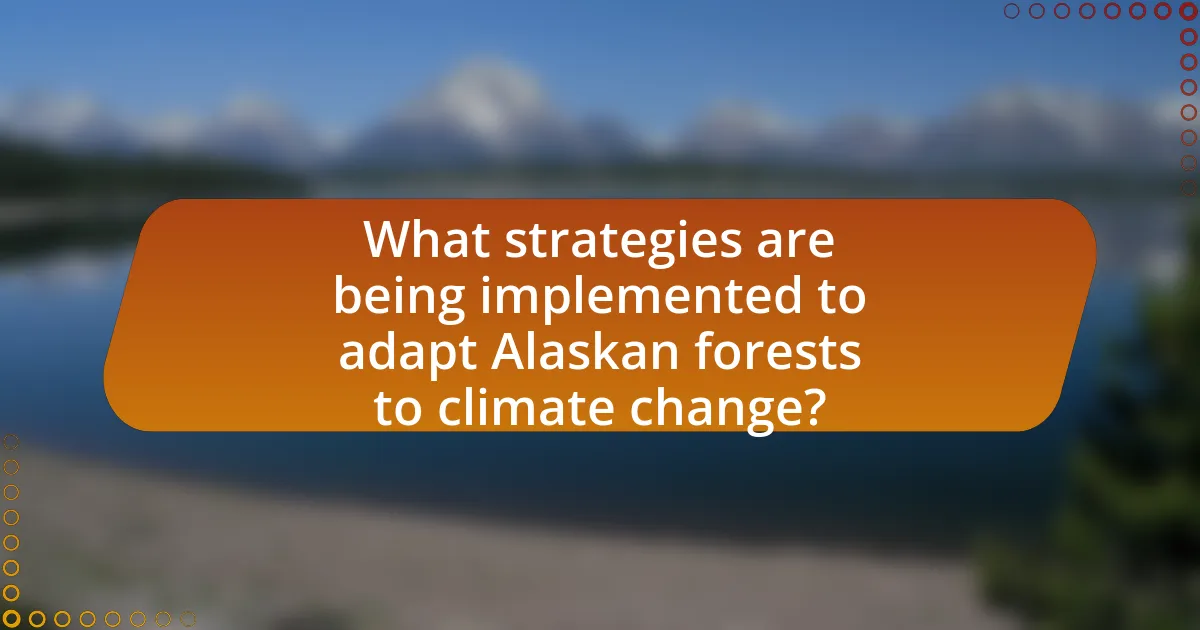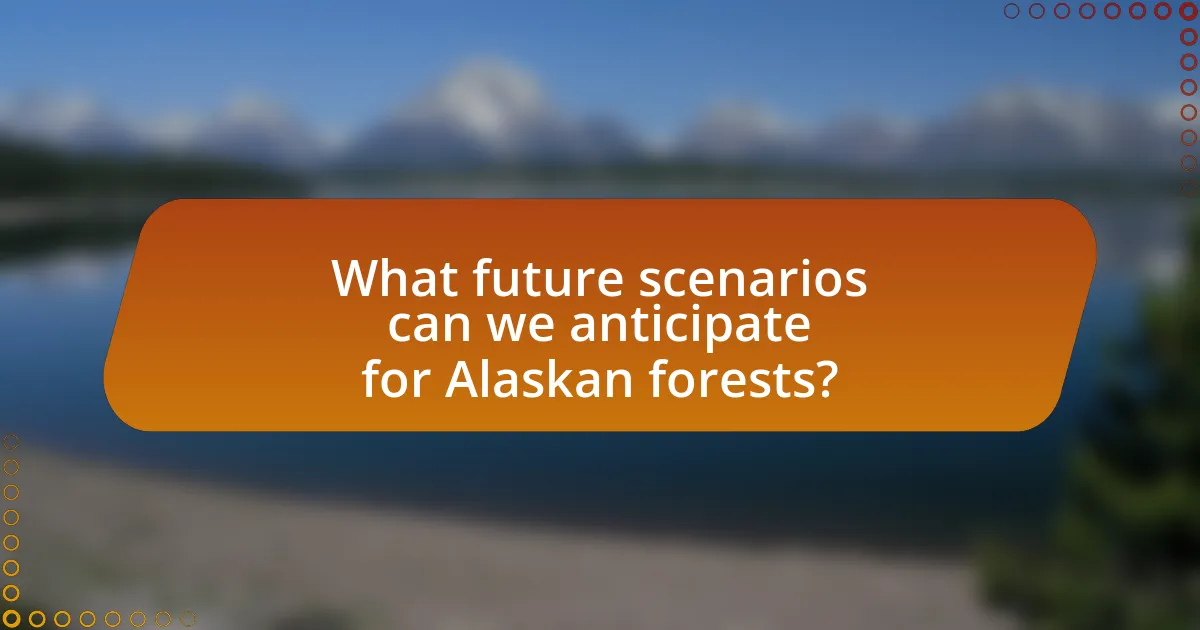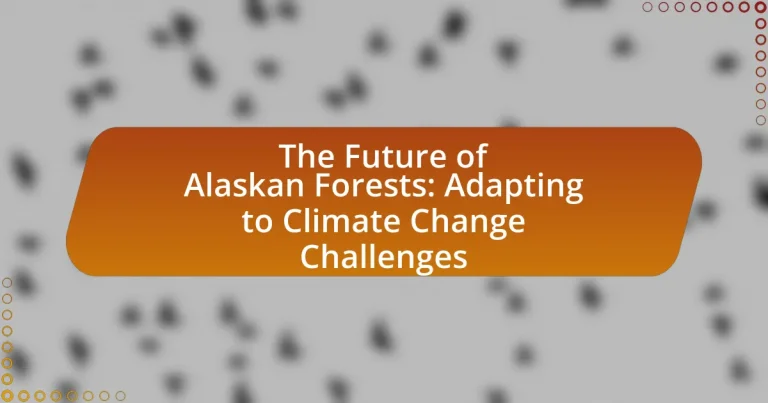The article focuses on the challenges faced by Alaskan forests due to climate change, including increased wildfires, pest infestations, and altered precipitation patterns. It examines the impacts of rising temperatures on forest ecosystems, species composition, and biodiversity, as well as the socio-economic implications for local communities reliant on forest resources. The article also discusses strategies for adaptation, such as selective logging, reforestation, and community involvement in conservation efforts, while highlighting the importance of maintaining forest health for carbon storage and ecosystem resilience. Future scenarios predict significant changes in forest composition and biodiversity, emphasizing the need for sustainable management practices to support the adaptation of Alaskan forests.

What are the current challenges facing Alaskan forests due to climate change?
Alaskan forests currently face significant challenges due to climate change, including increased wildfires, pest infestations, and altered precipitation patterns. The rise in temperatures has led to longer fire seasons and more frequent and intense wildfires, which can devastate large areas of forest. Additionally, warmer conditions have facilitated the spread of pests such as the spruce bark beetle, which has caused extensive tree mortality. Changes in precipitation patterns, including both increased rainfall and drought conditions, further stress forest ecosystems, impacting tree growth and health. These challenges threaten biodiversity, disrupt carbon storage, and affect the livelihoods of communities dependent on forest resources.
How is climate change specifically impacting the ecosystems of Alaskan forests?
Climate change is significantly impacting the ecosystems of Alaskan forests by altering species composition, increasing the frequency of wildfires, and affecting the timing of seasonal events. Warmer temperatures are leading to shifts in tree species, with species like white spruce becoming more dominant as conditions favor their growth over others. Additionally, the rise in temperatures and prolonged dry spells contribute to more frequent and intense wildfires, which can devastate large areas of forest and disrupt habitat for wildlife. Research indicates that the growing season is extending, causing mismatches in the timing of plant flowering and animal breeding, which can threaten biodiversity and ecosystem stability. These changes are documented in studies such as the 2020 report by the U.S. Forest Service, which highlights the vulnerability of Alaskan forests to climate-related disturbances.
What changes in temperature and precipitation patterns are observed?
Observed changes in temperature patterns in Alaska include an increase of approximately 3°F (1.6°C) over the past 60 years, with projections suggesting a rise of 6°F to 12°F (3.3°C to 6.7°C) by the end of the century. Precipitation patterns have also shifted, with annual precipitation increasing by about 15% since the 1950s, particularly in the form of rain rather than snow. These changes are supported by data from the National Oceanic and Atmospheric Administration (NOAA) and the Alaska Climate Adaptation Science Center, which document the warming trends and altered precipitation dynamics affecting the region’s ecosystems.
How do these changes affect plant and animal species in Alaskan forests?
Changes in climate, such as rising temperatures and altered precipitation patterns, significantly affect plant and animal species in Alaskan forests. These shifts lead to habitat loss for native species, as warmer conditions favor the encroachment of invasive species that outcompete local flora and fauna. For example, studies indicate that tree species like white spruce are experiencing stress due to increased temperatures and changing moisture levels, which can result in reduced growth and increased vulnerability to pests and diseases. Additionally, animal species, such as caribou and moose, face challenges as their food sources and migratory patterns are disrupted by changing vegetation dynamics. The U.S. Forest Service reports that these ecological changes can lead to declines in biodiversity, altering the balance of forest ecosystems and impacting the overall health of Alaskan forests.
What are the socio-economic implications of climate change on Alaskan forests?
Climate change significantly impacts the socio-economic landscape of Alaskan forests by altering ecosystems, affecting local economies, and influencing cultural practices. The warming climate leads to increased forest fires, pest infestations, and shifts in species distribution, which disrupt timber production and wildlife habitats essential for subsistence hunting and fishing. For instance, the U.S. Forest Service reports that the frequency of wildfires in Alaska has increased, threatening both the timber industry and the livelihoods of indigenous communities reliant on forest resources. Additionally, changes in forest composition can affect tourism, as visitors may be less inclined to explore areas that have been severely impacted by climate change. These socio-economic implications highlight the interconnectedness of environmental health and community well-being in Alaska.
How does climate change affect local communities that depend on forest resources?
Climate change significantly impacts local communities that depend on forest resources by altering ecosystems, reducing biodiversity, and affecting resource availability. As temperatures rise and precipitation patterns shift, forests face increased risks from pests, diseases, and wildfires, which can diminish the quality and quantity of timber and non-timber forest products. For instance, a study by the U.S. Forest Service indicates that climate change could lead to a 20-30% decline in suitable habitat for key tree species in Alaska by 2050, directly affecting the livelihoods of communities reliant on these resources for economic and cultural sustenance. Additionally, changes in forest composition can disrupt traditional practices and food sources, further threatening the social and economic fabric of these communities.
What economic activities are threatened by changes in forest health?
Changes in forest health threaten several economic activities, including timber production, tourism, and fisheries. Timber production is directly impacted as declining forest health leads to reduced tree growth and increased susceptibility to pests and diseases, which can diminish the supply of quality wood. Tourism, particularly in regions that rely on forested landscapes for recreational activities, suffers as forest degradation reduces the aesthetic and ecological value of these areas. Additionally, fisheries are affected because forest health influences watershed conditions; unhealthy forests can lead to increased sedimentation and altered water temperatures, negatively impacting fish habitats. These interconnections highlight the economic risks posed by declining forest health in Alaska.

What strategies are being implemented to adapt Alaskan forests to climate change?
Strategies being implemented to adapt Alaskan forests to climate change include selective logging, reforestation with climate-resilient species, and the establishment of protected areas. Selective logging reduces the impact on forest ecosystems while allowing for sustainable timber production. Reforestation efforts focus on planting tree species that are better suited to withstand changing climate conditions, such as increased temperatures and altered precipitation patterns. Additionally, the establishment of protected areas helps preserve biodiversity and maintain ecosystem services, which are crucial for forest resilience. These strategies are supported by research indicating that adaptive management practices can enhance forest health and sustainability in the face of climate change.
How are conservation efforts evolving in response to climate challenges?
Conservation efforts are evolving by integrating adaptive management strategies that address the specific impacts of climate change on ecosystems. For instance, in Alaska, conservationists are increasingly utilizing data-driven approaches to monitor forest health and biodiversity, allowing for timely interventions. Research indicates that adaptive management practices, such as controlled burns and selective logging, are being implemented to enhance forest resilience against climate-induced stressors like pests and wildfires. Additionally, collaborative initiatives involving local communities and indigenous knowledge are being prioritized to ensure that conservation strategies are culturally relevant and effective in mitigating climate impacts.
What role do protected areas play in forest adaptation strategies?
Protected areas play a crucial role in forest adaptation strategies by preserving biodiversity and maintaining ecosystem functions essential for resilience against climate change. These designated regions protect various species and habitats, enabling forests to adapt to shifting climatic conditions. For instance, studies have shown that protected areas can serve as refuges for species facing habitat loss due to climate change, allowing for natural migration and adaptation processes. Furthermore, they help maintain genetic diversity, which is vital for the adaptability of forest ecosystems. Research indicates that forests within protected areas are more likely to withstand climate-related stresses, such as increased temperatures and altered precipitation patterns, compared to unprotected forests.
How are restoration projects being designed to enhance resilience?
Restoration projects are being designed to enhance resilience by incorporating adaptive management strategies that focus on ecological diversity and climate change mitigation. These projects prioritize the restoration of native species and habitats, which are crucial for maintaining ecosystem functions and services. For example, the use of mixed-species plantings can improve forest resilience to pests and diseases, as diverse ecosystems are generally more robust. Additionally, restoration efforts often include the implementation of sustainable land management practices that reduce soil erosion and improve water retention, further supporting ecosystem stability. Research indicates that such approaches can significantly increase the ability of forests to withstand and recover from climate-related disturbances, thereby enhancing their long-term resilience.
What role does community involvement play in adaptation strategies?
Community involvement is crucial in adaptation strategies as it fosters local knowledge, enhances resilience, and promotes collective action. Engaging communities allows for the integration of traditional ecological knowledge with scientific approaches, leading to more effective and culturally relevant adaptation measures. For instance, studies have shown that communities actively participating in forest management can significantly improve biodiversity and ecosystem health, which are vital for adapting to climate change impacts. Additionally, community-driven initiatives often result in stronger social networks, enabling quicker responses to environmental changes and challenges.
How can local knowledge contribute to effective forest management?
Local knowledge can significantly enhance effective forest management by integrating traditional ecological insights with contemporary practices. This knowledge, often accumulated over generations, provides valuable information about local species, ecosystem dynamics, and historical land use patterns. For instance, Indigenous communities in Alaska possess extensive understanding of forest health indicators and species interactions, which can inform sustainable harvesting practices and biodiversity conservation strategies. Research indicates that incorporating local knowledge into forest management plans can lead to improved resilience against climate change impacts, as evidenced by case studies where such integration has resulted in better adaptation strategies and enhanced ecosystem services.
What initiatives are in place to engage communities in conservation efforts?
Initiatives to engage communities in conservation efforts include educational programs, community-based resource management, and collaborative restoration projects. Educational programs, such as workshops and school curricula, inform residents about local ecosystems and conservation practices. Community-based resource management empowers local populations to manage their natural resources sustainably, fostering a sense of ownership and responsibility. Collaborative restoration projects, often involving partnerships between government agencies, non-profits, and local communities, focus on reforestation and habitat restoration, directly involving community members in hands-on activities. These initiatives have been shown to enhance community involvement and improve conservation outcomes, as evidenced by successful projects in various regions that have led to increased biodiversity and ecosystem resilience.

What future scenarios can we anticipate for Alaskan forests?
Future scenarios for Alaskan forests include increased tree mortality, shifts in species composition, and altered ecosystem dynamics due to climate change. Research indicates that rising temperatures and changing precipitation patterns will lead to more frequent wildfires and pest outbreaks, significantly impacting forest health. For instance, a study by the U.S. Forest Service predicts that by 2050, up to 50% of Alaska’s boreal forests could experience severe stress from climate-related factors, resulting in a decline in tree species such as white spruce and an increase in more drought-resistant species. Additionally, the thawing of permafrost may release stored carbon, further exacerbating climate change effects and altering forest ecosystems.
How might forest composition change in the coming decades?
Forest composition in Alaska is likely to change significantly in the coming decades due to climate change, which is causing shifts in temperature and precipitation patterns. As temperatures rise, species such as white spruce and black spruce may decline, while species like aspen and birch could become more dominant, reflecting a transition to a more mixed forest type. Research indicates that by 2100, the range of boreal forest species may shift northward by up to 500 kilometers, leading to altered ecosystems and biodiversity. Additionally, increased frequency of wildfires and pest outbreaks, driven by warmer conditions, will further influence species distribution and forest health.
What species are likely to thrive or decline in a changing climate?
Species that are likely to thrive in a changing climate include invasive species such as the red alder and certain types of shrubs, which can adapt to warmer temperatures and altered precipitation patterns. Conversely, native species like white spruce and paper birch are likely to decline due to their sensitivity to temperature increases and changing soil moisture levels. Research indicates that as temperatures rise, the distribution of these species will shift, with invasive species outcompeting native flora, leading to significant changes in forest composition and ecosystem dynamics.
How will shifts in forest types impact biodiversity?
Shifts in forest types will significantly impact biodiversity by altering habitat availability and species interactions. As climate change influences forest composition, species that depend on specific forest types may face habitat loss or fragmentation, leading to declines in their populations. For instance, research indicates that warmer temperatures and changing precipitation patterns can shift boreal forests to more temperate ecosystems, which may not support the same range of species. A study by the U.S. Forest Service found that such shifts could lead to a loss of up to 30% of native plant species in some regions, directly affecting the animals that rely on them for food and shelter.
What are the long-term implications for carbon storage in Alaskan forests?
Long-term implications for carbon storage in Alaskan forests include increased carbon release due to permafrost thawing and changes in forest composition. As temperatures rise, permafrost, which stores significant amounts of carbon, is expected to thaw, releasing carbon dioxide and methane into the atmosphere. Research indicates that the boreal forests of Alaska, which currently act as carbon sinks, may transition to carbon sources if disturbances such as wildfires and insect outbreaks increase. A study by McGuire et al. (2018) in “Nature Climate Change” highlights that these changes could lead to a net loss of carbon storage capacity, exacerbating climate change effects.
How does forest health influence carbon sequestration capabilities?
Forest health significantly influences carbon sequestration capabilities by determining the biomass and productivity of trees, which directly affects the amount of carbon dioxide absorbed from the atmosphere. Healthy forests, characterized by diverse species, robust growth, and minimal disease or pest infestations, can sequester more carbon due to their higher rates of photosynthesis and greater overall biomass. For instance, a study published in the journal “Nature” found that well-managed forests can store up to 30% more carbon than degraded forests, highlighting the importance of maintaining forest health for effective carbon sequestration.
What measures can be taken to enhance carbon storage in these ecosystems?
To enhance carbon storage in Alaskan forests, implementing reforestation and afforestation practices is essential. These measures involve planting native tree species that are well-adapted to the local climate, which can significantly increase biomass and, consequently, carbon sequestration. Research indicates that forests can sequester approximately 1.1 billion metric tons of carbon dioxide annually, highlighting the potential impact of these practices. Additionally, improving forest management techniques, such as selective logging and controlled burns, can maintain ecosystem health and promote the growth of carbon-storing vegetation. Studies show that healthy forests can store up to 50% more carbon than degraded ones, reinforcing the importance of sustainable management practices.
What practical steps can be taken to support the adaptation of Alaskan forests?
To support the adaptation of Alaskan forests, implementing sustainable forest management practices is essential. These practices include promoting biodiversity by planting native species that are resilient to climate change, which can enhance ecosystem stability. Additionally, conducting regular monitoring of forest health and growth patterns allows for timely interventions to address emerging threats such as pests and diseases. Research indicates that adaptive management strategies, which incorporate scientific data and community input, can significantly improve forest resilience. For instance, the U.S. Forest Service has documented that adaptive management in Alaska has led to better outcomes in forest recovery and health.
How can individuals contribute to forest conservation efforts?
Individuals can contribute to forest conservation efforts by participating in local tree planting initiatives and supporting sustainable forestry practices. Engaging in tree planting helps restore ecosystems and combat climate change, as one mature tree can absorb approximately 48 pounds of carbon dioxide annually. Additionally, individuals can advocate for policies that protect forests, such as supporting legislation aimed at reducing deforestation and promoting conservation. By choosing products certified by organizations like the Forest Stewardship Council, individuals can also ensure that their consumption supports sustainable practices. These actions collectively contribute to the preservation and health of forests, particularly in regions like Alaska, which face significant climate change challenges.
What best practices should be adopted for sustainable forest management?
Best practices for sustainable forest management include implementing adaptive management strategies, promoting biodiversity, and engaging local communities in decision-making processes. Adaptive management allows for continuous learning and adjustment based on environmental changes, which is crucial in the context of climate change affecting Alaskan forests. Promoting biodiversity enhances ecosystem resilience, ensuring that forests can withstand and recover from disturbances. Engaging local communities fosters stewardship and ensures that management practices align with the needs and knowledge of those who rely on forest resources. These practices are supported by research indicating that integrated approaches lead to more resilient forest ecosystems and sustainable resource use.


